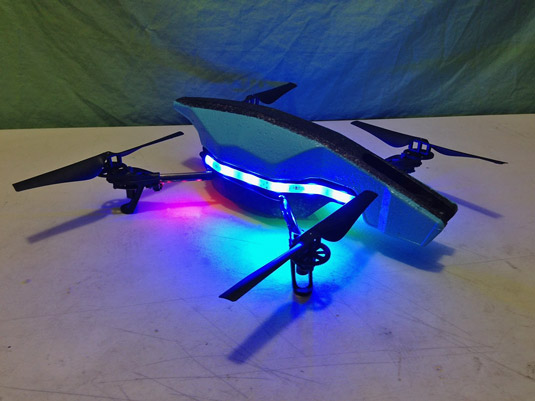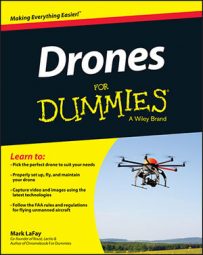Flying your drone indoors presents a unique set of risks and challenges, such as flying into people, furniture, ceilings, and floors. If you have pets, you have to be concerned with their curiosity with the flying chew toy. All of that aside, in case you want to fly inside, here are some tips to set you up for success.
Securing the area
Before you fire up your drone and take to the indoor “skies,” run through the following checklist to ensure a safe, and successful flight:
Make sure pets are out of the area. If you are flying at home, make sure that your pets are secured so that there is no possibility of them coming into the room while you are airborne. If you are flying in a public place, post notices and markers indicating the area of your flight.
Move or remove furniture from the room. In the event that your drone uses sonar to maintain altitude, this will save you the headaches of unexpected jumps and drops. If you need furniture in the room for a video that you are capturing with your drone, then consider rearranging the furniture so that your drone’s flightpath is free of objects that may interfere with your flight.
Reset your drone. Don’t forget that modern drones are advanced machines with advanced computers. Your drone will remember flight conditions, settings, and other variables that, if left unchecked, could make flying your drone increasingly more difficult. Resetting your drone will erase its memory and set you up for a fresh start. Most drones will come with a reset button. However, you may want to refer to your manual to ensure that you are resetting the device appropriately.
Adjust your flight controls. Many drones will allow you to have multiple control settings so that you can set different sensitivity levels for your flight controller. Make sure that your drone is either set to a pre-set for indoor flying, or manually reduce your drone’s control sensitivity. The last thing you want is to tap a directional control and have your drone go flying into something. Configuring controls is specific to the drone so be sure to refer to your drone’s user manual to learn how to adjust the sensitivity of your flight controller.
Knowing your drone
Every drone functions a little bit differently. For example, some drones use pressure gauges to determine altitude. Other drones use sonar to determine distance from the ground. Knowing how your drone functions helps you avoid disaster.
For example, if your drone uses sonar to calculate altitude, when you fly over a structure like a coffee table, your drone may quickly adjust thinking that all of a sudden it lost 2 to 3 feet of altitude. Soft materials absorb more sonar than they reflect, so if your drone goes over a couch, it may autocorrect thinking it is higher than it should be. Knowing these nuances could save you from calamity.
Using an indoor hull
Some drones come with a hull that shields the propellers from impact. If your drone supports an indoor hull or some sort of propeller guard, use it. If you get too close to a wall or a person the hull or shield will reduce the likelihood of a drone, or human, casualty.
![Parrot AR Drone 2.0 with and without an indoor hull. [Credit: Courtesy of Tucker Krajewski]](https://www.dummies.com/wp-content/uploads/483021.image0.jpg)
Avoiding ceilings, floors, and walls
It may seem obvious, but it can’t be stated enough. For drones to get airborne they must move a ton of air. The propellers force air down, which causes the air pressure below the drone to be higher than average and the air pressure above the drone to be lower than average. This creates a force called lift, which takes the drone airborne.

When you fly very close to the ground, the air is forced more sideways than down, which causes the drone to become unstable. If you fly too close to the ceiling, air can’t flow downward to the propellers and instead comes in from the sides. The air pressure then decreases even more, creating a vacuum effect and thus drawing the drone closer to the ceiling.
Avoiding walls is smart, as well, because the flow of air is impeded as you get closer to a wall, affecting the lift. Your drone will tilt toward the wall causing it to fly toward the wall and imminent doom. The rule of thumb is to fly in large, uncluttered rooms with high ceilings.
Stocking up on spare parts
This goes for flying in general but definitely if you are planning to do indoor flying. The odds are in favor of you crashing your drone, and it is a rarity to have a crash and not break something on your drone. Flying with damaged parts is not ideal because it can throw off your drone’s stabilization, causing it to fly erratically. For example, a damaged propeller, even if it is the most minute of defects, can cause your drone to be unbalanced.
Propellers are highly refined pieces of aerodynamic equipment. Slight variances in weight can make them move differently. Cuts or breaks can cause air to move over the propeller differently. Both of which will cause your drone to not function as it would with un-damaged propellers. That’s not safe for you or for your drone. In addition to spare parts, have a first aid kit on hand just in case the hard object your drone crashes into is you, your pet, or someone else.
The most cost effective way to stock up on spare parts is to go to sites like Amazon, robotshop.com or even on ebay.com. You can always go to your drone’s manufacturer’s website to shop for parts.

